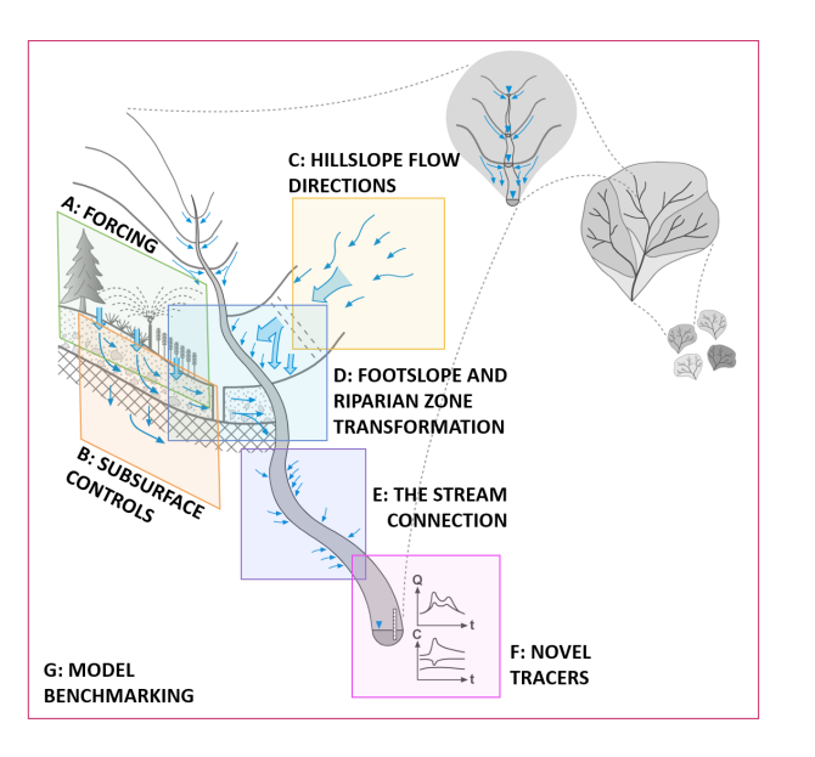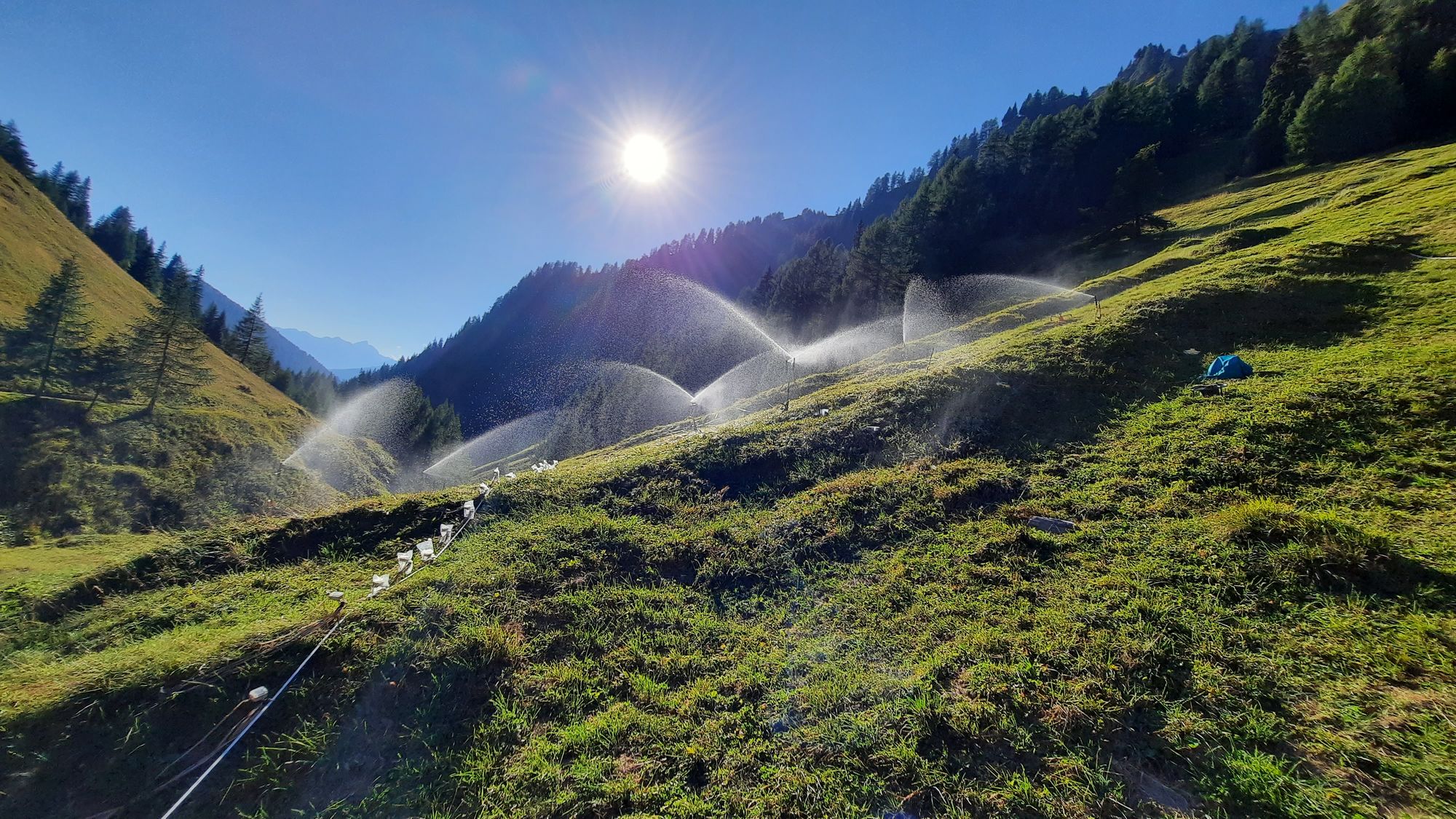A SSF FORCING - Temporal dynamics and land use effects of SSF - Irrigation experiments combined with ERT measurements [funded by DFG]
Project staff:
Emanuel Thoenes
Mag. Dr. Bernhard Kohl
Prof. Stefan Achleitner
Veronika Lechner
Prof. Markus Weiler
Abstract:

Within Project A - SSF Forcing, our aim is to systematically identify contributions from different sources to the subsurface storm flow (SSF) at the plot (small hillslope) scale. Therefore, artificial rainfall tests (ARS) are used in combination with artificially varying upslope boundary conditions. Dealing with different sites andland use allows to identify temporal dynamics and land use effects.
We are focusing on the experimental and numerical assessment of the effects of different forcing on subsurface stormflow (SSF) at the plot scale, which will support the modeling of SSF on the hillslope and catchment scales. The plot is seen as the least common denominator to assess SFF over these different scales. We address varying initial and boundary conditions as well as different soil and land use characteristics which affect the generation and the temporal dynamics of SFF.Aims are to derive thresholds and consequently a parameterization to describe the process dynamics. We will reach these aims by means of analysis of pre-existing data from artificial rainfall simulations (ARS) and from ARS conducted within this project. The planned tests will comprise quantitative flow measurements as well as qualitative assessment of fluxes and states in four research catchments with different characteristics.
Research questions:
1. How can fluxes and pathways of vertical and lateral SSF flow components be detected at the plot scale? Which tracers and measurement methods (e.g. TDR, stable isotopes, ERT) can be used to identify them?
2. How are inter-event dynamics affecting the proportion between surface runoff and SSF?
3. How are seasonal changes of land use and cover affecting SSF? How do temporal dynamics of precondition affect SSF?
4. What are the thresholds to initiate SSF on the plot scale? How variable and transferable are thresholds among sites and catchments (link to other catchments/sites)?
5. How well can we detect the spatial variability of preferential SSF using stable water isotopes or ERT during and after natural rainfall events? What is the spatial extent (area/flow length) contributing to SSF?
 Methods
Methods
The work program focuses on the driving forces of SSF and the identification of impacts on SSF temporal dynamics combining innovative sprinkling experiments with permanent, and campaign-based measurements involving different tracer methods. WP1 and WP2 contain the plot scale sprinkling experiments, planned and applied at the trenched plots studying the effect of different initial and boundary conditions such as rainfall, runon or subsurface inflow. The irrigation experiments will be combined with the application of different tracer methods (projects A, C, D, F), installed soil moisture measurements (projects A, H), ERT measurements (projects A, B), and UHF radar (ext. coop. project A) in all four test sites. WP3 deals with the analysis, evaluation and the uncertainty assessment, were the outputs of WP 1 and 2 are combined to establish links between forcing, boundary conditions and SSF dynamics. WP4 addresses regionalization for modelling dealing with the distribution of driving forces among plot scales and at sub catchment level, in order to better identify parameter settings used for an improved modelling. In WP 5, numerical modeling of the processes on the plot scale is performed with models of different complexity.
Achievements
Two Subsurface Stormflow-capturing trenches in the black forest (Germany) were used to gain following insights on the SSF response to natural rainfall events: The generated SSF volume is primarily controlled by total rainfall (P) and antecedent wetness, with volumes being up to three orders of magnitude larger under wet initial conditions. The volume increased gradually with P at one trench whereas it displayed a threshold-like behavior at the other. Peak SSF flow rates of smaller events were influenced by P and antecedent conditions, but for larger events, rainfall intensity was one of the dominant controls along with the rainfall amount preceding peak rainfall intensity. The steepness of the rising limb was correlated with P and rainfall intensity.
Preliminary results of the artificial rainfall simulations carried out above 11 trenches, located in the four research catchments, highlighted the vastly different responses between sites; while some trenches remained dry, others were characterized by extremely high subsurface runoff coefficients and short response times.
Publications and poster presentations:
- Thoenes, E.; Kohl, B.; Lechner, V.; Pyschik, J.; Weiler, M. & Achleitner, S. (2025.04.28). Exploring Subsurface Stormflow through Sprinkling Experiments at Multiple Trenchsites. Presented at EGU, Vienna.
2024 - Thoenes, E.; Kohl, B.; Weiler, M. & Achleitner, S. (2024.04.16). Influence of rainfall event characteristics on the subsurface stormflow response: a multi-site analysis. Presented at EGU, Vienna.
